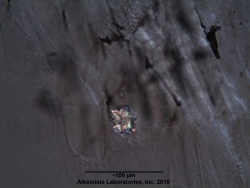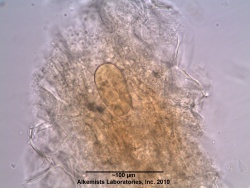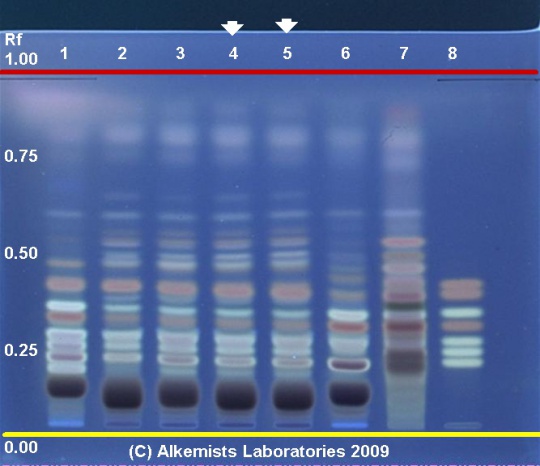Panax ginseng (root)
(to new format) |
|||
| Line 1: | Line 1: | ||
| − | + | {{DISPLAYTITLE:''Panax ginseng'' (root)}} | |
| − | '' | + | =Nomenclature= |
| − | + | =Botanical Voucher Specimen= | |
| − | + | =Organoleptic Characteristics= | |
| − | + | =Macroscopic Descriptions= | |
| − | + | =Microscopic Characteristics= | |
| − | + | {| border=1 | |
| − | + | | | |
| − | + | {{Microscopy | source=Elan M. Sudberg, Alkemist Laboratories | |
| − | + | | companyimage=AP-LOGO-Laboratories Crop - Copy.jpg | |
| − | = | + | | companyURL= http://www.alkemist.com |
| − | = | + | | description= Cellular structures identified in ''Panax ginseng'' root are the rosettes of calcium oxalate and yellow secretion from a resin canal when observed at 400x with Acidified Chloral Hydrate Glycerol Solution. |
| − | {{Microscopy | source=Elan M. Sudberg, Alkemist Laboratories | + | |
| − | | companyimage= AP-LOGO-Laboratories Crop - Copy.jpg | + | |
| − | | companyURL=http://www. | + | |
| − | + | ||
| − | + | ||
| − | | description= | + | |
| − | + | ||
| − | + | ||
| − | + | ||
| reference=W.H.O. Monographs Vol. #1 1999 | | reference=W.H.O. Monographs Vol. #1 1999 | ||
| }} | | }} | ||
| + | {| border=1 | ||
| + | | {{botcon |companyimage= AP-LOGO-Laboratories Crop - Copy.jpg | ||
| + | | companyURL= http://www.alkemist.com}} || {{botcon |companyimage= AP-LOGO-Laboratories Crop - Copy.jpg | ||
| + | | companyURL= http://www.alkemist.com}} | ||
| + | |- | ||
| + | | {{botimg |mainimage= Panax Ginseng C.A. Mey -Araliaceae--1.jpg | ||
| + | |caption1= Rosettes of calcium oxalate observed at 400x with Acidified Chloral Hydrate Glycerol Solution. | ||
| + | |source= Elan M. Sudberg, Alkemist Laboratories http://www.alkemist.com}} | ||
| + | | {{botimg |mainimage= Panax Ginseng C.A. Mey -Araliaceae--2.jpg | ||
| + | |caption1= Yellow secretion from a resin canal from ''Panax ginseng'' root observed at 400x with Acidified Chloral Hydrate Glycerol Solution. | ||
| + | |source= Elan M. Sudberg, Alkemist Laboratories http://www.alkemist.com}} | ||
| + | |} | ||
| + | |||
| + | |} | ||
| + | |||
| + | =High Performance Thin Layer Chromatographic Identification= | ||
| − | |||
{{HPTLC | source=Elan M. Sudberg, Alkemist Laboratories | {{HPTLC | source=Elan M. Sudberg, Alkemist Laboratories | ||
| description=Asian Ginseng (root) (''Panax ginseng'') | | description=Asian Ginseng (root) (''Panax ginseng'') | ||
| Line 54: | Line 60: | ||
| }} | | }} | ||
| − | = | + | =Supplementary Information= |
| + | |||
| + | =Sources= | ||
| + | |||
| + | <references /> | ||
Revision as of 17:27, 18 February 2014
Contents |
Nomenclature
Botanical Voucher Specimen
Organoleptic Characteristics
Macroscopic Descriptions
Microscopic Characteristics
|
High Performance Thin Layer Chromatographic Identification
|
Asian Ginseng (root) (Panax ginseng) Lane Assignments Lanes, from left to right (Track, Volume, Sample):
Reference materials used here have been authenticated by macroscopic, microscopic &/or TLC studies according to the reference source cited below held at Alkemists Laboratories, Costa Mesa, CA. Stationary Phase Silica gel 60, F254, 10 x 10 cm HPTLC plates Mobile Phase chloroform: ethyl acetate: CH3OH: water [3/8/4.4/1.8] Sample Preparation Method 0.3 g + 3 ml 70% grain EtOH sonicate 10 minutes no heat Detection Method 10% Methanolic H2SO4 -> 115° C 15 min -> UV 365 nm Reference see American Herbal Pharmacopoeia & Therapeutic Compendium
|
Supplementary Information
Sources
- ↑ Elan M. Sudberg, Alkemist Laboratories http://www.alkemist.com
- ↑ Elan M. Sudberg, Alkemist Laboratories http://www.alkemist.com
- ↑ Elan M. Sudberg, Alkemist Laboratories http://www.alkemist.com
- ↑ Elan M. Sudberg, Alkemist Laboratories http://www.alkemist.com




